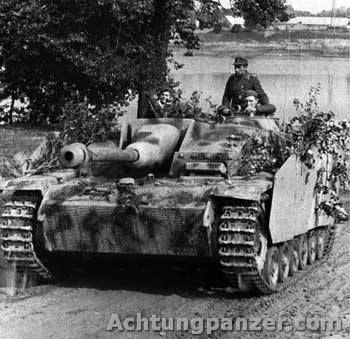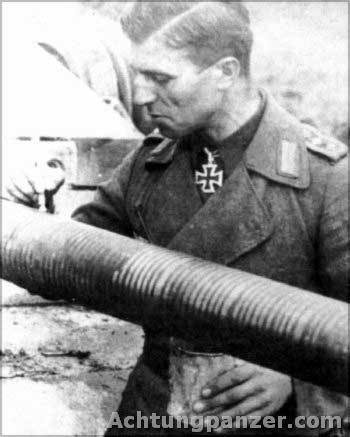Labels
EN VERSION
(25)
Luna Plus/Online Game
(24)
ID Versi
(12)
internet
(10)
Info about Land Area
(7)
Computer
(6)
Dongeng
(5)
Fairy tale
(5)
Operator Seluler
(4)
Tank
(4)
facebook
(2)
security
(2)
Information
(1)
Komputer
(1)
Web Browser
(1)
Blog Archive
-
2012
(68)
- May(21)
-
April(45)
- Web
- Computer
- Luna Plus/Luna Online Game
- Label
- Site Map
- Home
- Luna Plus / Luna Online Monster Drop List
- GF luna Lvling Guide
- Celestia Luna LVLing GUIDE
- Luna Online Rare Weapons Drop list
- Luna Online / Luna Plus pet skill guide
- Luna Plus / Online Boss Locations
- Luna Plus/Celestia Req EXP to level
- Luna Plus/Online enchant success guide
- Luna Online / plus job change locations
- Luna Plus/Online celestia/GF all job full guide
- Luna Plus/Online Costume Set
- Optional Set Luna plus/Luna Online
- Rare Robe Set List Luna Plus / Online
- Rare Light Armor Set Luna Plus/Online
- Heavy Armor Set Luna Plus/Online
- RARE NECKLACE,BELTS AND BADGES Luna Plus/Online
- RARE RINGS AND EARRINGS Luna Plus/Online
- Luna Plus / Online Rare Helmets
- Luna Plus/Online Rare Shield
- Luna Plus / Online Farm Guide
- Luna Online Fishing guide
- Luna Plus Pet Guide
- Luna Plus Job Tree (UPDATED)
- Luna Online/Plus Construct and deconstruct guide
- HOW TO MAKE/ASSEMBLE A DESKTOP PC (TUTORIAL)
- Anti Copy Script For HTML(BLOGGER,JOOMLA,WORDPRESS...
- Free CMS Templates (Joomla,Drupal,DotNetNuke,Wordp...
- Bali Island
- Info About Indonesia Country!
- How To Register At WWW.Blogger.COM
- How To Save The EARTH
- Effect Of Computers Hardware
- Free Virtual VGA
- What Happened When A Nuclear Missile is Launched! ...
- North Korea Ballistic Missile Program
- M4 Sherman Battle Tank
- STUG IV GERMAN BATTLE TANKS
- STUH 42 German TANK
- Flight 19's History
- January(2)
- 2011 (3)
STUG IV GERMAN BATTLE TANKS
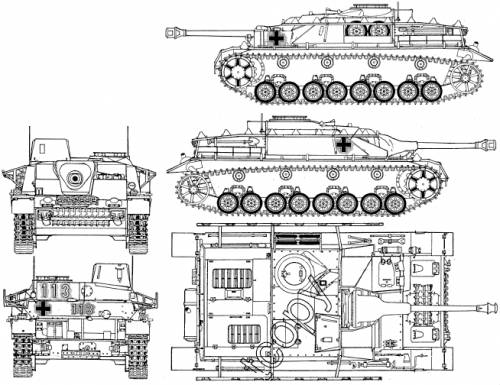

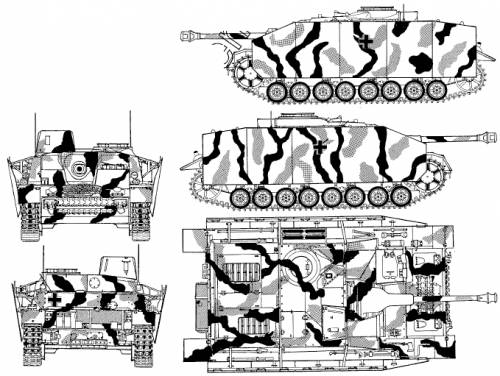

STUG IV GERMAN TANK'S BLUEPRINT

STUG IV IMAGE (REAL IMAGE)
Sturmgeschutz III/IV
Sturmgeschütz III Ausf A-E / Sd.Kfz. 142 Gepanzerter Selbstfahrlafette für Sturmgeschütz 7.5cm Kanone Ausf A-E Sturmgeschütz III Ausf F-G / Sd.Kfz. 142/1 Gepanzerter Selbstfahrlafette für Sturmgeschütz 7.5cm Sturmkanone 40 Ausf F-F/8
7.5cm Sturmgeschütz 40 Ausf G Sturmgeschütz IV / Sd. Kfz. 167
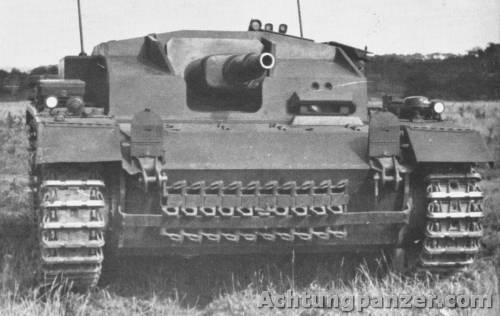 Stug III Ausf E |
Sturmgeschütz III Ausf E "Forward and at the enemy ! Assault guns are an offensive weapon and give the infantry immediate, powerful support through mobility, fire and striking power."
Sturmgeschütz Training Manual.
Sturmgeschütz Training Manual.
Stug III was one of a series of assault guns/tank destroyers produced by the Germans during the war. Assault guns were easier, cheaper and less time consuming to produce than turreted tanks and that is why German factories built them in large numbers. Cost of single Ausf G was 82500RM making it cheaper than both PzKpfw III Ausf M at 103163RM and PzKpfw IV Ausf F2 at 115962RM. It is interesting to see that almost four Ausf Gs could be purchased for the cost of single King Tiger.
In 1935, Colonel Erich von Manstein proposed that Sturmartillerie units were to be formed and used for direct support of infantry divisions. They were to be equipped with assault guns mounted on tracked chassis. Used to accompany the infantry into the attack, the assault gun’s main aim was to knock out pill-boxes, machine gun nests, anti-tank guns and other obstacles.
On June 15 1936, the order was given to Daimler-Benz AG to develop and produce an armored infantry support vehicle mounting 75mm gun. The gun was to have a limited traverse of minimum 25 degrees in order to provide direct support up to 6 kilometres. The gun was to be mounted in a superstructure that provided full protection for the crew. The height of this vehicle was not to exceed the height of an average man. Daimler-Benz AG being already involved in the development and production of Panzerkampfwagen III tank decided to use its chassis and components for this new vehicle. The experimental "0" series of five prototypes (chassis number 60201 to 60215) was produced in 1937 by Daimler-Benz - Pz.Sfl.III (s.Pak). Prototypes were pre-productionPanzerkampfwagen III Ausf B tanks mounted with mild-steel superstructures housing short-barrelled 75mm StuK (Sturmkanone) gun designed and produced by Krupp. Vehicles were extensively tested at Kummersdorf, Doberitz and other testing / training facilities e.g. Jueterbog. Prototypes remained in use as training vehicles as late as 1942.
First production vehicles based on Panzerkampfwagen III Ausf F chassis and components, entered production in 1940. The 75mm StuK 37 L/24 gun was mounted offset to the right in a sloped superstructure. Superstructure was made of armor plates and was mounted on the welded hull. Side hull escape hatches present in the original Panzerkampfwagen III Ausf F hull were removed and frontal hull armor protection was increased from 30mm to 50mm. From January to May of 1940, 30 Sturmgeschutz III Ausf A were produced by Alkett.
First 24 Stug III Ausf A assault gun out 30 produced equipped Sturmartillerie Batteries 640, 659, 660 and 665 and first saw service during the French Campaign. Each battery according to organization scheme from November of 1939 had 6 assault guns in three platoons (with 2 assault guns each). Sturmartillerie Battery 640 became organic to Infantry Regiment Grossdeutschland and was renamed to 16th Sturmartillerie. Last 6 assault guns were issued to SS Sturmartillerie battery of Leibstandarte SS Adolf Hitler division. Two more batteries were formed - 666th and 667th but didn’t see combat in France.
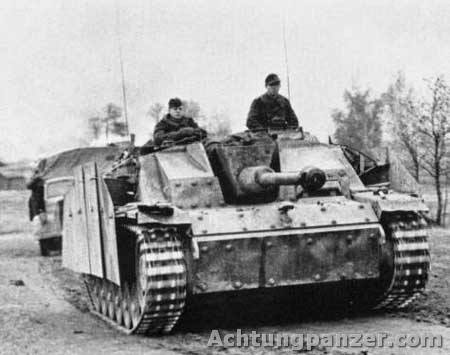 Early Stug III Ausf G in Russia |
Early Stug III (40) Ausf G in Russia.
In August of 1940, Sturmartillerie units were reorganized into Abteilungen (battalions) with 18 assault guns in three batteries (with 6 assault guns each). In early 1941, the battalions were renamed - Sturmgeschuetz Abteilungen and batteries to Sturmgeschuetz Batteries. In March/April of 1941, all Sturmgeschuetz Batteries had the number of assault guns increased to seven.In 1942, with the introduction of long-barrelled Stug III (75mm L/43 and L/48), Sturmgeschuetz Abteilungen were reformed and number of assault guns was increased to 28 per battalion. Each battalion still had three batteries but number of assault guns in platoons was increased to three. In November of 1942, Sturmgeschuetz Abteilungen were reformed again and number of assault guns was increased to 31 per battalion with three additional assault guns for battery commanders. This type of organization often referred to as Sturmgeschuetz Brigade remained in use until the end of the war. In June of 1944, new organization scheme was introduced - Sturmartillerie Brigade with 45 assault guns, including 33 Stug III/IV (75mm L/48) assault guns and 12 Sturmhaubitze 42 (105mm L/28) assault howitzers. Brigade had three batteries with 2 Stug IIIs for each battery command, while each battery had two platoons of four Stug IIIs and one of four StuH 42s. This organization scheme was used alongside the Sturmgeschuetz Brigade scheme to the end of the war. In practice, these ideals were hardly ever achieved and then only highly favoured formations received the full complement.
Towards the end of the war, Stugs (40) were often issued to other units as replacement for tank destroyers and even tanks.Since 1944, Stug III (40) were also used as replacements for PzKpfw III,PzKpfw IVand even PzKpfw V Panther in Panzer Abteilungs. That practice was a mistake, but the desperate situation and the overall shortage of tanks made it a necessity. During the course of war, Stug III assault guns were issued to Sturmartillerie Batteries, Sturmgeschuetz Abteilungen, Sturmgeschuetz Brigades, Sturmartillerie Brigades, Ersatz (Reserve) Abteilungen and Funklenk (Remote Control) Companies. Stug III assault guns served on all fronts of WWII to the end of the war.Only, elite Wehrmacht (e.g. Grossdeutschland) and Waffen SS (eg. LSSAH, Das Reich, Totenkopf) divisions had Sturmgeschutzbrigaden as permanent part of their divisions.
Sturmgeschutz III was originally designed as an assault weapon, but as war progressed it became more of a defensive one.It evolved into an assault gun and tank destroyer in one. Its main role was to providing anti-tank support to the units in its area of operation.
| Variant: | Production Period: | Number Produced: |
| Ausf A | January - May 1940 | 30 |
| Ausf B | June 1940 - May 1941 | 320 |
| Ausf C | May - September 1941 | 50 |
| Ausf D | May - September 1941 | 150 |
| Ausf E | September 1941 - March 1942 | 272 |
| Ausf F | March - September 1942 | 359 + 1 prototype |
| Ausf F/8 | September - December 1942 | 334 |
| Ausf G | December 1942 - March 1945 | 7720 + 173 converted |
Ausf A was followed by improved Ausf B, C, D and E, all armed with short 75mm StuK 37 L/24 gun. All versions featured number of modifications specific to vehicles that followed them in production. Last Ausf E was produced in March of 1942. Total of 822 Ausf A, B, C, D and Es was produced by Alkett and their official designation was Gepanzerter Selbstfahrlafette fur Sturmgeschutz 7.5cm Kanone Ausf A-E / Sd.Kfz.142. Early Stugs remained in active service until mid 1943. Many Early models were recalled to the factory to be rearmed with newer guns and up-armored by addition of armor plates. Some older variants returned for repairs were often re-equipped with parts from newer variants creating completely non-standard variants (e.g. Stug III Ausf C armed with 75mm StuK 40 L/48 gun in Saukopf mantlet destroyed at Altdamm, 1945 and Stug III Ausf E armed with 75mm StuK 40 gun destroyed in Berlin, May 1945).
Stug III Ausf E was the first of the series to be provided with 7.92mm MG34, which was carried inside the superstructure for local defense.
Three Ausf D vehicles were send to North Africa and saw service with Sonderverband z.b.V 288 - special deployment unit.
In March of 1942, Ausf F entered production. It was not only an assault gun but also a badly needed tank destroyer. Early models were mounted with long 75mm StuK 40 L/43 and late models (31) with longer L/48 gun. It was produced until September 1942 with 359(360) produced. Ausf F was then replaced by Ausf F/8 armed exclusively with L/48 gun. It was produced until December of 1942 with 334 produced. Ausf F/8 paved the way for final Sturmgeschutz III model - Ausf G. Stug III Ausf F, F/8 and G’s were also called Stug III (40), because they were all armed with 75mm StuK 40 guns. Stug III Ausf F and Ausf F/8 were produced by Alkett and their official designation was Gepanzerter Selbstfahrlafette fur Sturmgeschutz 7.5cm Sturmkanone 40 Ausf F-F/8 / Sd.Kfz.142/1
In order to improve Stug III’s performance,in 1942, small number of various Stug III models (from Ausf B to Ausf F) was rearmed with 75mm Stuk L/33 guns, which externally resembled 105mm StuH 42 L/28 howitzers causing confusion. In reality Sturmgeschutz was never armed with this of gun. 75mm Stuk L/33 gun was invented by the British, who misinterpreted German photos of Stug III Ausf F with its longer L/43 gun, which had the muzzle break painted out by censors as new type of gun - L/33.
In May and June of 1943, 10 of retired and battle damaged Stug III Ausf F/8 were converted into flame-thrower tanks armed with 14mm Flammenwerfer. They were designated as Sturmgeschutz III (Fl). From June of 1943 to January of 1944, all Sturmgeschutz III (Fl) were used for training in Germany, while from January to April of 1944 all were rearmed with 75mm StuK 40 L/48 guns.
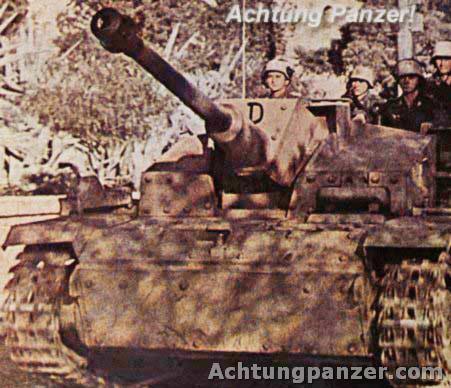 Stug III Ausf F/8 |
Stug III Ausf F/8, Athens, Greece, 1943.
Ausf G entered production in December of 1942 and remained in production until March/April of 1945. It was the most numerous from all Sturmgeschutz III guns and some 7893 were produced by Alkett (Altmaerkische Kettenfabrik GmbH) and MIAG (Muehlenbau-und-Industrie AG). Production reached its peak when in 1944, 4013 Ausf Gs left factories. Alkett produced over 5000 Ausf, while MIAG began production in March of 1943 and produced some 3000 vehicles. Production numbers include 165 PzKpfw III Ausf M chassis used to produce Ausf Gs in 1943 and 173 PzKpfw III Ausf Ms converted to Ausf Gs by Alkett and MIAG in 1944. Ausf G was produced in four production series - chassis numbers 76101 to 77550, 91751 to 94250, 95001 to unknown and 105001 to unknown.
Ausf G used Ausf F/8’s hull, suspension, engine and other components, while superstructure was modified. Superstructure was widened, its 30mm sides were sloped at 79 degrees, the roof was raised in the rear and its rear 30mm superstructure wall was mounted at 90 degrees. This provided more room for both the commander and loader.
Stug III Ausf G
|
The other changes included the layout of the roof, addition of commander’s cupola with seven periscopes (each could be moved up or down) and sighting flap for binocular spotting telescope along with a 10mm machine gun shield in front of loader’s hatch (from December of 1942 to April of 1944). Early vehicles had movable cupola (until October of 1943), mid vehicles had it mounted in a fixed position (until October of 1944) and late vehicles again had movable cupola with additional protective cover. Also, early vehicles had 50mm frontal hull armor increased to 80mm by addition of 30mm bolted armor plate, while vehicles produced since May of 1943 by Alkett and since October of 1943 by MIAG had 80mm frontal hull armor. Early models were also mounted with KFF2 (Kampfwagen Fahrer Fernrohr) driver’s episcopes.
|
During the production, modifications were made to Ausf G. They included introduction of 80mm cast Saukopf (also known as Topfblende) mantlet in February of 1944; the coaxial MG in early 1944, installation of Nahverteidigungswaffe (90mm NbK 39 close-in defense weapon) and roof mounted remote controlled MG (Rundum Feuer) in late spring of 1944. In addition, vehicles produced since January of 1943 had the fighting compartment fan mounted on the rear superstructure wall instead of the roof. Two kinds of "Saukopf" mantlet were produced and mounted on Stug III Ausf G, one housing only the gun and other housing the gun and coaxial machine gun (from September of 1944). Original "boxy" gun mantlet was made of 50mm (front) and 30mm (sides) armor plates. Ausf Gs were also mounted with 5mm Schurzen since mid 1943.
Stug III Ausf F, F/8 and G’s were also called Stug 40 Ausf F, F/8 and G, because they were all armed with 75mm StuK 40 guns. Those last three models performed the role of tank destroyers rather than that of assault guns.
On August 1st of 1940, it was planned to convert 12 Sturmgeschutz IIIs into submersible assault guns in preparations for the Invasion of England (Operation Sealion) but conversion never took place.
From April to June of 1943, some 61 Stugs were assigned to Panzerkompanien (Funklenk) as command vehicles for SdKfz.301 (Schwere Ladungsträger Ausf A/B/C - Borgward) tracked demolition charge layers, which were radio-controlled.
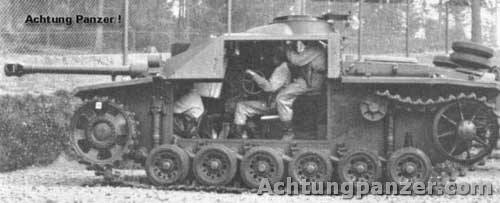 Stug III Ausf G |
Sturmgeschutz III’s design underwent many changes including various modifications madeto the suspension (e.g. sprocket and idler design), superstructure (e.g. headlights, shape, size, ventilator, cupola) and other equipment (e.g. sight, remote control machine gun). Each variant featured some modifications to the overall design, creating the visible difference between Ausf B and Ausf G.All Stug IIIs were operated by the four men crew - commander, gunner, loader / radio operator and driver.
Very common field practice was the addition of a layer of concrete added over the armor plate above the driver’s position to improve the protection. Since mid 1943, Stug IIIs were also equipped with Schurzen (armor skirts) for further protection. Also many earlier version were recalled to the factory to be rearmed with never guns and up-armored by addition of armor plates. Number of vehicles was also mounted with additional armor plates during their service by field workshops.Some older variants returned for repairs were often re-equipped with parts from newer variants creating completely non-standard variants.Models produced between September of 1943 and September of 1944, were factory applied with Zimmerit (anti-magnetic paste) with "waffle plate" or standard design. At the same time, many Stug IIIs already in service were also applied with Zimmerit.Very common were the canister/storage racks or steel rails mounted on the engine compartment.
|
Sturmgeschütz AcesProbably the most successful engagement involving Sturmgeschutz III Ausf F took place in Stalingrad in early September of 1942. Stug III Ausf F from Stug.Abt.244, commanded by Oberwachtmeister Kurt Pfreundtner destroyed 9 Soviet tanks in 20 minutes. On September 18th of 1942, Oberwachtmeister Kurt Pfreundtner received the Knights Cross for this achievement.
|
Another Sturmgeschutz ace was the Knights Cross holder Wachtmeister Kurt Kirchner from Stug.Abt.667, who destroyed 30 Soviet tanks during few days in February of 1942 during fighting in Northern Russia.
Hauptmann Peter Franz also the Knights Cross holder and the commander of Stug.Abt. "Grossdeutschland" destroyed some 43 Soviet T-34/76 tanks during the Battle for Borissovka on March 14th of 1943.
Left: Knight’s Cross holder Oberwachtmeister Hugo Primozic of Stug.Abt.667.
In the middle of July of 1941, Oberfeldwebel Rudolf Jaenicke (Stug number 25), commander of Stug platoon destroyed 12 Soviet BT-2 tanks along with tractors and other equipment loaded on rail platforms.
Between 1st and 4th of January of 1943, Unteroffizier Horst Naumann from Stug.Abt.184 destroyed 12 Soviet tanks during heavy fighting in the Demyansk area. On January 4th, Naumann was awarded with Knight’s Cross for destruction of total of 27 enemy tanks.
The most notable of all Stug aces were von Malachowski, Franz and especially Knight’s Cross holder Oberwachtmeister Hugo Primozic of Stug.Abt.667.
The most notable Waffen SS Stug ace was SS-Sturmbannfuehrer Walter Kniep, who commanded the 2nd Sturmgeschuetz Abteilung of 2nd SS Panzer Division "Das Reich". From July 5th of 1943 to January 17th of 1944, his unit claimed destruction of some 129 Soviet tanks, while losing two Stugs. Kniep was then awarded the Knight’s Cross.
Overall, Sturmgeschutz series proved to be very successful, and served on all fronts as assault guns and tank destroyers in both offensive and defensive mode. Sturmgeschutz III with its low silhouette was a difficult target and a dangerous opponent. Sturmgeschutz crews were considered to be the elite of the artillery units and were issued special field grey (version of panzer) uniforms. Sturmgeschutz units held very impressive record of tank kills some 20000 enemy tanks by spring of 1944.As of April 10th of 1945, there were 1053 Stug IIIs and 277 StuH IIIs in service.Approximately 9500 Sturmgeschutz IIIs of various types were produced until March of 1945 by Alkett and small number by MIAG.
Sturmgeschütz III - Sd.Kfz. 142
- Ausf A - 75mm StuK 37 L/24
- Ausf B - 75mm StuK 37 L/24
- Sturminfanteriegeschütz 33 Ausf B - 150mm sIG33 L/11
- Ausf C - 75mm StuK 37 L/24
- Ausf D - 75mm StuK 37 L/24
- Ausf E - 75mm StuK 37 L/24
- Sturminfanteriegeschütz 33 Ausf E - 150mm sIG33 L/11
Sturmgeschütz III (40) - Sd.Kfz. 142/1
- Ausf F - 75mm StuK 40 L/43 and L/48
- (10.5cm) Sturmhaubitze 42 Ausf F / Sd.Kfz. 142/2 - 105mm StuH 42 L/28
- Ausf F/8 - 75mm StuK 40 L/43 and L/48
- Sturminfanteriegeschütz 33 Ausf F/8 - 150mm sIG33 L/11
- Ausf G "Fruhe" - 75mm StuK L/48
- Ausf G "Spat" - 75mm StuK L/48
- (10.5cm) Sturmhaubitze 42 Ausf G / Sd.Kfz. 142/2 - 105mm StuH 42 L/28
Sturmgeschütz IV - Sd.Kfz. 167
- Sturmgeschütz IV - 75mm StuK 40 L/48
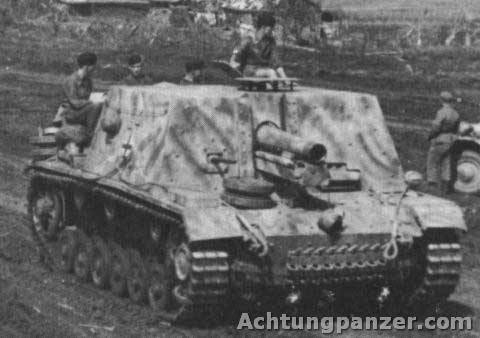 Stug 33 |
Sturminfanteriegeschütz 33
from 9th company of 201st Panzer Regiment from 23rd Panzer Division,
near village of Marinowka, Russia, 1943.
from 9th company of 201st Panzer Regiment from 23rd Panzer Division,
near village of Marinowka, Russia, 1943.
Sturm-Infanteriegeschutz 33 was a heavy infantry gun carrier designed and produced by Alkett. From December of 1941 to October of 1942, total number of 24 s.I.G.33 auf Fgst. Pz.Kpfw.III (Sfl.) was made (chassis number 90101 to 91400). Its design was based on Stug III Ausf B’s chassis, while production models on Stug III Ausf E (12) and F/8’s (12) chassis. It was armed with 150mm L/11.4 heavy infantry gun. Storage space allowed only 30 of 150mm rounds and 600 rounds for MG34 to be carried inside the vehicle. Stug 33s were operated by the crew of 5 and were used exclusively on the Eastern Front. 12 of 24 Stug 33s produced were used in fighting in Stalingrad with Sturmgeschutz Abteilung 177 and 244, where they were all lost. The other 12 were used by Sturm-Infanteriegeschutz-Batterie Lehr Battalion XVII (training battalion) and then with 23rd Panzer Division. Specifications for Sturminfanteriegeschütz 33
| Weight: | 21000kg |
| Crew: | 4-5 men |
| Engine: | Maybach HL 120 TRM / 12-cylinder / 300hp |
| Speed: | Road: 20km/h Cross-Country: –km/h |
| Range: | Road: 110km Cross-Country: 85km |
| Fuel Capacity: | 320 litres |
| Length: | 5.40m |
| Width: | 2.90m |
| Height: | 2.30m |
| Armament: | 150mm sIG 33 L/11.4 & 1 x MG34 7.92mm (1 x MG34 - hull) (2 x MP38 - inside) |
| Ammo: | 150mm - 30 rounds 7.92mm - 600 rounds |
| Armor: | 10-80mm |
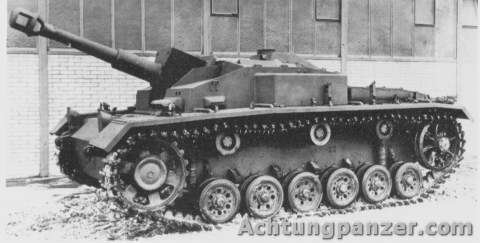 Sturmhaubitze 42 (Sd. Kfz. 142/2) |
Early Sturmhaubitze 42 (Sd. Kfz. 142/2).
In October of 1942 Sturmhaubitze 42 was produced by Alkett, its design was based on Stug III Ausf F and F/8’s chassis and it was armed with 105mm StuH 42 L/28 (L/30) howitzer. From 1943 onwards StuH 42 was built on Ausf G’s chassis. Vehicles of this type were modified in the same way as Ausf Gs were. Early vehicles were fitted with muzzle brakes but since September of 1944, it was decided that it wasn’t needed. From October of 1942 to February of 1945, 1212 Sturmhaubitze mit 10.5 cm Sturmhaubitze 42 Ausf G were produced (chassis number 91651 to unknown and 105001 to unknown). The main role of StuH 42 was to support Stug IIIs and infantry.
In 1944 and 1945, small number of Stug III Ausf Gs were converted into (75mm/105mm rounds) ammunition carriers by the removal of the gun and covering the opening with a piece of armor plate. Those vehicles were known as Munitionspanzer auf Fahrgestell Sturmgeschutz III Ausf G / Munitionpanzer Sturmgeschütz III Ausf G.
In 1944 and 1945, small number of Stug III Ausf Gs were converted into (75mm/105mm rounds) ammunition carriers by the removal of the gun and covering the opening with a piece of armor plate. Those vehicles were known as Munitionspanzer auf Fahrgestell Sturmgeschutz III Ausf G / Munitionpanzer Sturmgeschütz III Ausf G.
In November of 1944, there was also a project by Krupp to modify Stug III/IV and to arm it with 88mm Pak 43/3 L/71 gun but it never reached the prototype stage.
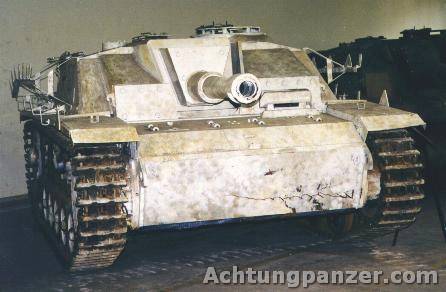 Sturmhaubitze 42 (Sd. Kfz. 142/2) |
Sturmhaubitze 42 (Sd. Kfz. 142/2).
Picture provided by Eric Peytavin. SU(Samokhodnaja Ustanovka)-76i(inostranny)
and
SG(Samochodnaya Gaubitza)-122A
Picture provided by Eric Peytavin. SU(Samokhodnaja Ustanovka)-76i(inostranny)
and
SG(Samochodnaya Gaubitza)-122A
From 1941 to 1943, Russians captured large numbers of PzKpfw III, PzKpfw IV and Stug III (known to them as ArtSturm).Especially large number was captured at Stalingrad. Some were pressed into temporary service (e.g. being used as "Trojan Horses" or as "bait"), because of their small caliber armament and lack of ammunition.
"It is suggested to the Red Army to use such German tanks as StuG III and Pz IV due to their relability and availability of spare parts. The new German Panther and Tiger can be used until they broken down without trying to repair them. They have bad engines, transmission and suspension." - Department of Weaponry of the Red Army, late 1944.
It was then decided to convert them to assault guns designated SU-76i (inostranny - foreign). Modifications consisted of the removal of the turret and upper part of the hull in case of PzKpfw III /PzKpfw IV and the superstructure in case of Stug III, while all other components remained unchanged. Modified vehicles were mounted with welded boxy superstructures (20-30mm), making vehicle 2.38 meters high. It was fully enclosed with flush hatches and without any kind of a cupola. Command version of SU-76i was mounted with PzKpfw III/IV’s commander’s cupola. Superstructures housed 76.2mm Tank Gun S-1 (cheaper version of F-34 tank gun) in the gun mount adapted fromT-34/76.Inside the superstructure there was storage space for 98 rounds. SG(Stug)-122A was very similar in design to SU-76i, but it was armed with 122mm M-30 self-propelled howitzer, mounted in totally modified frontal plate. Only small number (8-12?) of SG-122A (SU-122i) was produced. SU-76i was operated by the crew of four, who had two PPS model 1941 machine guns and twenty hand grenades for local defense. Driver used unchanged German equipment, while other equipment was of Russian origin. SU-76i weighted 22000kg and could travel at the maximum speed of 50km/h on the road. SU-76i’s road range was 180km, while cross-country was 115km. Range could be extended, since some vehicles were mounted with external tanks mounted on their engine decks.
Some 201 SU-76is were produced from March to November of 1943 at Factory #37 in Sverdlovsk.SU-76i had its debut in July of 1943 at Kursk and served in both tank and light mechanized gun regiments of the Red Army. Germans encountered first examples of SU-76i (from 177th Tank Regiment of the 64th Mechanised Brigade) in October of 1943.Some were recaptured by the Germans as Stug 76mm and pressed into service against their former users.
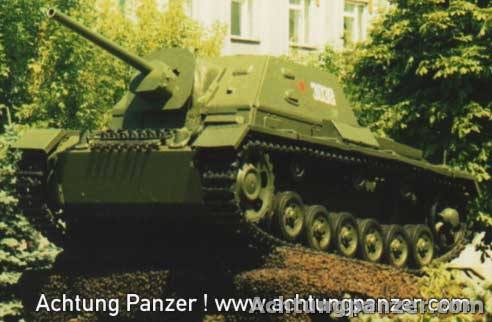 SU-76i |
SU-76i at Lenin Prospekt Memorial at Sarny, Ukraine.
Today, SU-76i based on PzKpfw III Ausf H/J can be seen as a monument at Sarny in Ukraine. This particular vehicle was supporting the 143rd Rifle Division during their advance on Sarny on January 11th of 1944. The SU-76i attempted to cross the frozen river but ice broke and it sunk with its crew. It was discovered in 1972, recovered, renovated and placed on display at Lenin Prospekt Memorial at Sarny.Second SU-76i is on display in Moscow, Russia.
SU-76i - Gallery
SU-76i - Gallery
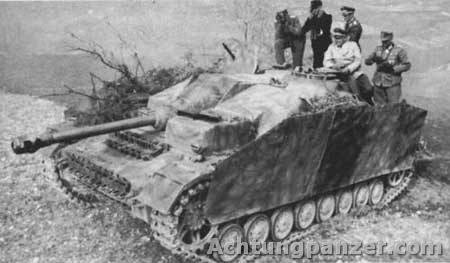 Stug IV |
Sturmgeschütz IV (Sd.Kfz.167) being presented to
Field Marshal Albert Kesselring (Army Group C) in Italy, 1944.
Field Marshal Albert Kesselring (Army Group C) in Italy, 1944.
In December of 1943, Stug IV was introduced, it was essentially a slightly modified Stug III superstructure (such as extended driver’s compartment) mounted on Panzer IV chassis. From December of 1943 to March of 1945, 1139 such "hybrids" were produced by Krupp-Gruson at Magdeburg (chassis number 89324 to 89382 and 100001 to unknown). Stug IV (Sd.Kfz.167) was armed with 75mm StuK 40 L/48 gun mounted in cast "saukopf" mantlet. It was operated by 4 men crew. Majority was issued in companies to infantry divisions with few exceptions. Some source apply designation Sd.Kfz.163to Stug IV.
Tests were also carried with Stug IV with rigid mounted 75mm L/70 gun but those were never fully concluded.
In preparations for the Ardennes Offensive, number of late Stug III Ausf Gs was converted to strange looking vehicles, which suppose toresemble American vehicles. They all equipped Panzer Brigade 150 along with Ersatz M10s (PzKpfw V Panther Ausf Gs converted to resemble Gun Motor Carriage M10 tank destroyer).
In preparations for the Ardennes Offensive, number of late Stug III Ausf Gs was converted to strange looking vehicles, which suppose toresemble American vehicles. They all equipped Panzer Brigade 150 along with Ersatz M10s (PzKpfw V Panther Ausf Gs converted to resemble Gun Motor Carriage M10 tank destroyer).
Sturmgeschutz was also exportedto Germany’s allies: Romania (119 Ausf F/8 and G), Bulgaria (55 Ausf G) , Hungary (40 Ausf G), Italy (5 Ausf G), Spain (10 Ausf F/8 and G) and Finland (59 Ausf G). Stug III Ausf G was known to Romanian Army as TAS T-III (tun de asalt T-III) and remained in service until early 1950s.In Bulgaria, Stug III Ausf G was known as SO-75.
During the war, Croatia, Sweden, Portugal, Turkey and Switzerland were interested in purchasing Stug III (40)s and StuH 42s but transactions were never finalized.
After the war ended, approximately 28 Stug III Ausf Gs found their way to Syria from France, Spain and Romania and served there until 1967. Few were captured by Israelis at the Golan Heights and atleast one is on display at the Museum of Armored Forces at Latrun.
Some Stug III Ausf Gs were also used by Norway along with PzKpfw IIIs - for more info visitNorwegian Panzers article. Small number was also used by Czechoslovakia and Yugoslavia.Finnish Stug III Ausf Gs - "Sturmi"
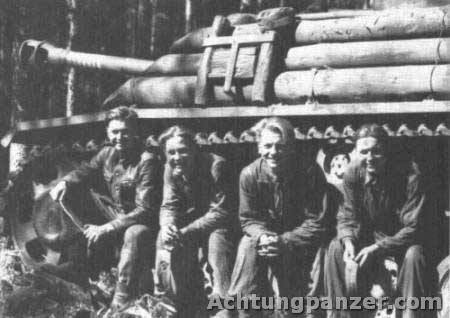 Crew of Ps.531-10 |
Top Finnish Stug III Ausf G (Ps.531-10) crew.
From left on commander Borje Brotell, loader Armas Launikko, gunner Olli Soimala and driver Sulo Kauppi.Side logs can be seen in this picture. That "box" on logs is holder for spare roadwheel. Picture is taken 7.7.1944
In 1943, Finland bought 30 Stug III Ausf Gs (early model) and in the summer of 1944, another 29 Stug III Ausf Gs (middle/late model). Finish Stugs received the tactical marking Ps (Panssarivaunu - armored vehicle) 531 followed by the number of the vehicle (e.g. Ps.531-19).The crews for the first 30 Stug III Ausf Gs were trained in Germany.
Finns modified their Stugs during the battles of 1944.Modifications included the addition of three wooden logs to both sides of the superstructure,armor around the gun mantlet was reinforced with concrete, tracks were mounted onthe lower front hull and both sides of the hull along with stowage bins. The original German MG-34 machine gun was replacedwith Soviet 7.62mm DT machine gun, which was in Finnish opinion more reliable.
Crew training was very demanding and for example gunners had to write their nameson a sheet of paper hanging on a tree with a pencil attached to the gun barrel using the gun aiming wheels. Stugs equipped the Assault Gun Battalion of the Finish Armored Division.Total amount of enemy tanks destroyed by Finnish Stugs was 87 tanks, while ownlosses were 8 assault-guns. Highest score for single Stug was 11 kills by Ps.531-10 commanded by Senior SergeantBorje Brotell and gunner Corporal Olli Soimala.Borje Brotell’s Stug III Ps.531-10 is today restored and located in the home of Finnish Armour, the Armoured brigade’s garrison at Parola,near barracks of 1st Armor Company.
In post-war years, Finns modified their vehicles even further by mounting a plate cover over the driver’s visor, new headlight near the driver’s position, as well as large stowage box on the right hand side and handles. Some vehicles were mounted with additional armor plates on the hull sides behind the road wheels. Modified Stugs remained in active service with Finnish Army until 1966. After that they were used for target practice or were dug into the ground around some important airfields to serve as protection against "unwanted landings". Today a few of them are restored and preserved in museums in Finland, England and Germany.
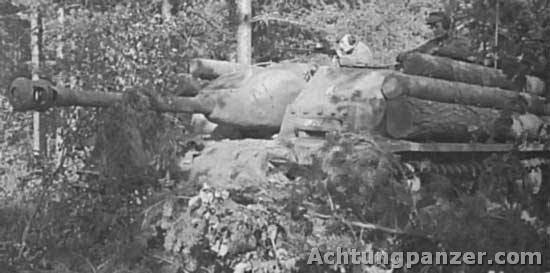 Finnish Stug |
Finnish Stug III Ausf G.
This Stug shows clearly Finnish modifications. Concrete bumps and logs are clearly visible. Note the Soviet 7.62mm DT machine gun.
This Stug shows clearly Finnish modifications. Concrete bumps and logs are clearly visible. Note the Soviet 7.62mm DT machine gun.
Pictures provided by Antti Syrjanen, Finland.
Stugs in Armor-Museum in Parola.
Stugs in Armor-Museum in Parola.
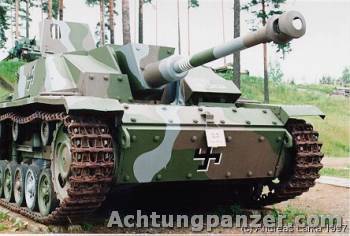 | |
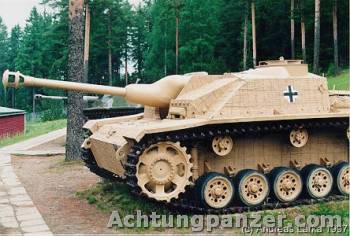 | |
| Stug III Ausf G (early version) | Stug III Ausf G (middle/late version) |
Stug III Ausf G (early version) numbered Ps.531-19 "Marjatta", which arrived to Finland in 1943. It is restored to the original colors used by the Finns during the war. It was the first Finnish Stug ever to fire at a Russian tank.
|
Ps.531-19 in action !Ps.531-19 commanded by Lieutenant Mauri Sartio destroyed 4 enemy tanks in a very short period of time. Gunner was Corporal Olof Lagus (he was a son of commander of Finnish Armour Division Ruben Lagus). On June 14th of 1944, Finns attacked to retake the village of Kuuterselkä. It was the first time when Finnish Stugs were used in action. It started near midnight (in the Summer it is not dark at night in Finland). First Stugs destroyed some machine guns and anti-tank guns. Suddenly, Sartio’s Stug saw Soviet T-34/85 just 15 meters left to their Stug. As fast as a lightning, driver turned Stug 90 degrees to the left, and Corporal Lagus fired. T-34 started to burn immediately. When it started to burn, Sartio’s crew saw numerous other soviet tanks. Young Corporal fired again and two other T-34 tanks were destroyed. Two other T-34 tanks tried to escape, but Lagus destroyed one of them and second T-34, which managed to drive 70 meters, was destroyed by other Stug. All this had taken only 1 to 2 minutes. All Soviet tanks were T-34/85 tanks and ready for action, but fast reaction of Finnish tankers spoiled their opportunity. Amount of enemy tanks destroyed by Stugs in this attack was 11 T-34/85 tanks, 2 ISU-152 assault guns, 1 IS-2 tank and 1 KV-1 tank.
Information provided by Antti Syrjanen, Finland.
Stug III Ausf G (middle/late version) numbered Ps.531-57 ("Ulla"). The museum has restored it to the colors it had and the condition it was in, when it arrived to Finland in 1944. The color of course is dark yellow and the Zimmerit-coating has been reapplied.These Stugs were not repainted in the Finnish scheme mentioned above during the summer of 1944, they only got extra protection of logs on the sides of the fighting compartment and concrete beside the main gun andoff they went to the front. Not even the German crosses were overpainted since they couldn’t be seen under the logs.
Labels:
EN VERSION,
Tank



